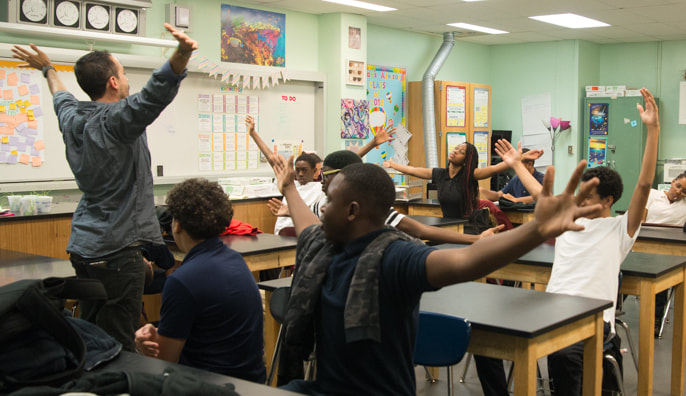Creating Mindfulness Experiences for Adolescents |
| Even though these adolescents’ educational contexts are very different, a couple of things are true for all of them. The adolescent years are challenging, confusing, and filled with changes to the body, their brain, and relationships. Adolescence is a tumultuous time of our lives! Let’s also not forget about technology and the impact it’s having on our children. Most of us can probably remember what it was like to be bored when we were young and not have a screen readily available. Our parents would tell us to figure it out, go outside, go play. Or they would assign us a chore to make sure we didn’t stay bored. These moments of boredom often led to free play, which is critical in child development. According to the American Academy of Pediatrics free play helps children develop their imagination, curiosity, and healthy relationships with the children around them and their parents. Whether we think the advent of technology is good or bad, it is here to stay and it is rewiring our children’s minds. Many have a harder time focusing their attention and developing relationships outside of their digital persona. |
The developing brains of adolescents
When I taught mindfulness to my teens in the Bronx, I often introduced the book Brainstorm by Dr. Daniel Siegel. Even though it was a challenging text for them to get through, they were engaged with the book because it was giving them insight into the way adults looked at them. It helped them understand what was changing in their brains and effecting the way they were feeling and acting. I will summarize some of the things I shared with my students here, but if this is a topic, you think would be helpful to you or your students will find interesting, make sure to add Brainstorm to your reading list.
Myths of adolescence
The way we see adolescents becomes the way they see themselves. These misunderstandings can lead to confusion and conflict for teens and adults. Which of these myths are you familiar with?
1. Raging hormones cause teenagers to “go mad” or “lose their minds.”
According to Siegel hormones do increase, but these levels then stay consistent throughout much of adulthood. Its not the hormones that are causing behavior changes. What adolescents experience is primarily the result of natural and needed changes in their developing brains.
2. Teens are immature and need to grow up.
The risk-taking tendencies, impulsiveness, and high emotional sensitivity of teens is not a sign of immaturity but rather an outcome of exactly what they are supposed to be doing during this developmental stage—testing boundaries, creating their own view of the world, and preparing for life beyond the family home and school community.
3. Growing up requires moving from dependence on adults to total independence from them.
The healthy move to adulthood is toward interdependence, not complete do-it-yourself isolation. Giving care and receiving help from others is the model we should be supporting.
Pause, take a couple of breaths, and reflect on your own middle or high school experience. I’m sure you can understand why adolescents struggle during this time of their lives especially if the adults around them fundamentally misunderstand them. Remembering our own experience can help us be more understanding and compassionate in the interactions we have with teens.
1. Raging hormones cause teenagers to “go mad” or “lose their minds.”
According to Siegel hormones do increase, but these levels then stay consistent throughout much of adulthood. Its not the hormones that are causing behavior changes. What adolescents experience is primarily the result of natural and needed changes in their developing brains.
2. Teens are immature and need to grow up.
The risk-taking tendencies, impulsiveness, and high emotional sensitivity of teens is not a sign of immaturity but rather an outcome of exactly what they are supposed to be doing during this developmental stage—testing boundaries, creating their own view of the world, and preparing for life beyond the family home and school community.
3. Growing up requires moving from dependence on adults to total independence from them.
The healthy move to adulthood is toward interdependence, not complete do-it-yourself isolation. Giving care and receiving help from others is the model we should be supporting.
Pause, take a couple of breaths, and reflect on your own middle or high school experience. I’m sure you can understand why adolescents struggle during this time of their lives especially if the adults around them fundamentally misunderstand them. Remembering our own experience can help us be more understanding and compassionate in the interactions we have with teens.
Qualities of the adolescent mind
Dr. Siegel goes on to name the attributes of the adolescent mind as well as the benefits and challenges associated with these changes. His book also guides reader through activities that ask adolescents to reflect and bring awareness to their internal landscape, and which support healthy communication.
Novelty Seeking
Increased drive for rewards and increased inner motivation to seek new experiences and feel life more fully
Social Engagement
Enhanced peer connectedness and new friendships are explored
Increased Emotional Intensity
Emotional sensitivity increases, allowing teens to feel life experiences more intensely
Creative Exploration
Expanded sense of being leads to conceptual thinking that question status quo and approaches problems with out-of-the-box solutions
Taking these findings into account highlights why mindfulness interventions are critical at this age.
There is promising, if nascent evidence, that mindfulness can support adolescent well-being by supporting development of their prefrontal cortex (where empathy, thinking of consequences, and other executive function skills live), by enhancing their ability to focus, and helping them name and regulate their emotions. In addition, studies of adults participating in mindfulness interventions like Mindfulness Based Stressed Reduction “suggest that participation in MBSR is associated with changes in gray matter concentration in brain regions involved in learning and memory processes, emotion regulation, self-referential processing, and perspective taking.” These research studies, coupled with my experience teaching adolescent, makes it easy to argue for introducing mindfulness interventions to adolescents.
Introducing mindfulness to teens can be especially rewarding and challenging. Working with adolescents can bring to the surface the unresolved feelings and painful experiences we faced as adolescent. To be effective with this age group, we must reflect and turn to our own practice. We also have to make sure that when we offer mindfulness to adolescents it is relevant and engaging otherwise we won’t be able to truly support them.
Working with teens, some of these apply to all age groups, but they hold special importance when working with adolescents. Adolescence spans from the ages of 12 to 24. This is one of the most confusing times of our lives, even when things are going well.
Argos Gonzalez is a teacher, lecturer, and mindfulness and yoga instructor. He has 14 years of experience teaching high school in the Bronx and teaches pre-service and in-service teachers at Hunter College School of Education in NY. Argos is certified through both Mindful Schools and Little Flower Yoga (LFY), and currently serves as the director of professional development for The School Yoga Project, a program of LFY and Lead Teacher for Mindful School’s Mindful Teacher yearlong certification program.
This article first appeared on LittleFlowerYoga.com, and is reposted with permission from the author.
Novelty Seeking
Increased drive for rewards and increased inner motivation to seek new experiences and feel life more fully
- Upside: Being open to change and exploring new ways of doing things that lead to a sense of adventure
Social Engagement
Enhanced peer connectedness and new friendships are explored
- Upside: The drive for social connection leads to creation of supportive relationships that can support and enrich teens their whole life
- Downside: Adolescents might isolate themselves from other adults and only surround themselves with other teens, which can lead to increased risky behavior
Increased Emotional Intensity
Emotional sensitivity increases, allowing teens to feel life experiences more intensely
- Upside: Emotional intensity can fill teens with energy and a sense of vitality for being alive
- Downside: Emotional intensity can fill teens with energy and a sense of vitality for being alive. Emotions can rule the day, leading to moodiness and, sometimes unhelpful, reactivity
Creative Exploration
Expanded sense of being leads to conceptual thinking that question status quo and approaches problems with out-of-the-box solutions
- Upside: Sense of wonder, creativity, and curiosity can be nurtured; new solutions and strategies for a fuller life are explored
- Downside: New explorations can lead to crisis of identity, susceptibility to peer pressure, and lack of direction or purpose
Taking these findings into account highlights why mindfulness interventions are critical at this age.
There is promising, if nascent evidence, that mindfulness can support adolescent well-being by supporting development of their prefrontal cortex (where empathy, thinking of consequences, and other executive function skills live), by enhancing their ability to focus, and helping them name and regulate their emotions. In addition, studies of adults participating in mindfulness interventions like Mindfulness Based Stressed Reduction “suggest that participation in MBSR is associated with changes in gray matter concentration in brain regions involved in learning and memory processes, emotion regulation, self-referential processing, and perspective taking.” These research studies, coupled with my experience teaching adolescent, makes it easy to argue for introducing mindfulness interventions to adolescents.
Introducing mindfulness to teens can be especially rewarding and challenging. Working with adolescents can bring to the surface the unresolved feelings and painful experiences we faced as adolescent. To be effective with this age group, we must reflect and turn to our own practice. We also have to make sure that when we offer mindfulness to adolescents it is relevant and engaging otherwise we won’t be able to truly support them.
Working with teens, some of these apply to all age groups, but they hold special importance when working with adolescents. Adolescence spans from the ages of 12 to 24. This is one of the most confusing times of our lives, even when things are going well.
- Remember what your adolescence was like, and have compassion!
- Students’ feelings should be validated always, but especially keep this in mind now, because many adults are dismissive of the strong emotions of teens.
- Practices, conversations, and activities should be relevant to the students’ lives.
- Learning should be student centered when possible, and students should be given opportunities to share and interact with one another.
- Students tend to be sensitive about the way they are perceived by others, but they might not fully understand how they perceive themselves.
- Support healthy identity formation by creating a culture of acceptance of individual difference and respect for personal boundaries.
- Avoid stereotypical language, and recognize your own assumptions and biases.
Argos Gonzalez is a teacher, lecturer, and mindfulness and yoga instructor. He has 14 years of experience teaching high school in the Bronx and teaches pre-service and in-service teachers at Hunter College School of Education in NY. Argos is certified through both Mindful Schools and Little Flower Yoga (LFY), and currently serves as the director of professional development for The School Yoga Project, a program of LFY and Lead Teacher for Mindful School’s Mindful Teacher yearlong certification program.
This article first appeared on LittleFlowerYoga.com, and is reposted with permission from the author.
Archives
March 2021
February 2021
January 2021
December 2020
September 2020
July 2020
May 2020
April 2020
March 2020
January 2020
December 2019
November 2019
October 2019
September 2019
August 2019
July 2019
June 2019
April 2019
February 2019
December 2018
November 2018
October 2018
September 2018
August 2018
July 2018
May 2018
April 2018
March 2018
January 2018
December 2017
November 2017
October 2017
September 2017
August 2017
July 2017
June 2017
May 2017




 RSS Feed
RSS Feed

